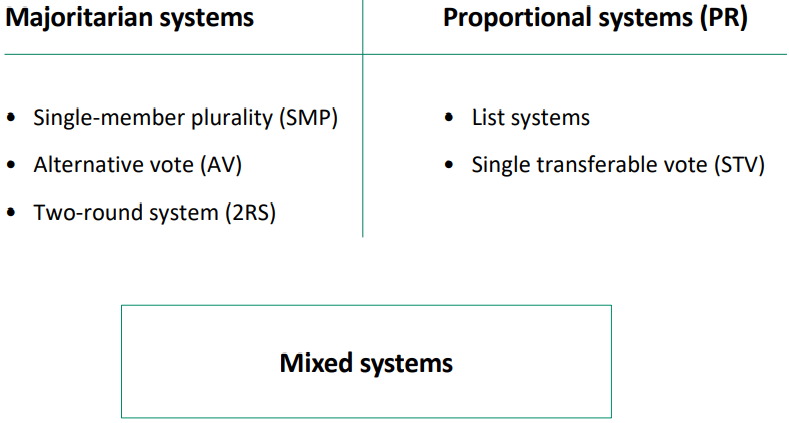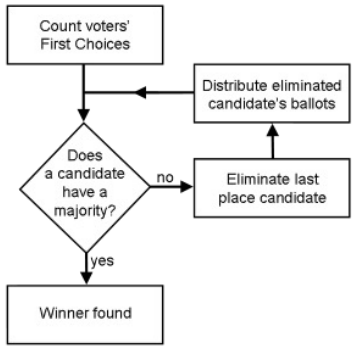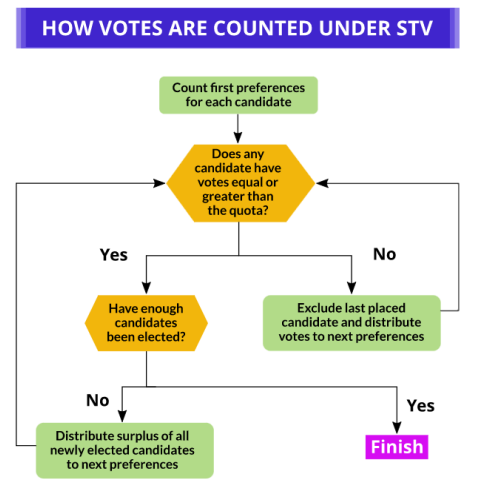Electoral systems and Representation
1/33
Earn XP
Description and Tags
week 4
Name | Mastery | Learn | Test | Matching | Spaced |
|---|
No study sessions yet.
34 Terms
prospective voting
= an election allowing the voter to be forward looking and think about what they expect the government to do
delegation → who does the ultimate principal delegate their authority to (who do they choose for their own representation)
representation
(ex ante)
retrospective voting
= an election allowing the voter to evaluate the performance of the incumbent government
accountability
representation
(ex post)
main differences between single member plurality (SMP) and proportional representation (PR) systems
Aspect | Single-Member Plurality (SMP) | Proportional Representation (PR) |
|---|---|---|
Seat Allocation | Winner-takes-all in each constituency. Each constituency elects one representative. | Multiple representatives are elected from larger, multi-member constituencies based on the overall vote share. |
Representation | Tends to produce concentrated representation, often favoring two major parties. | Tends to produce diverse and proportional representation, allowing smaller parties to win seats. |
Wasted Votes | Many wasted votes for losing candidates or beyond what the winner needs are wasted. | Fewer wasted votes because all votes contribute to seat allocation based on party vote share. |
Coalition Governments | Less common because a single party often secures a majority of seats. | More likely because no single party usually wins an outright majority. Coalition formation is common. |
Voter Choices | Voters typically vote for a candidate representing their geographic constituency. | Voters often vote for a political party, focusing on party platforms and policies. |
advantages and disadvantages of SMP
SMP
advantages:
simplicity → voter only votes one candidate
strong local representation → every constituency has its own representative (positive connection between constituency and elected candidate)
accountability
stability → majority governments with a single party in power can lead to increased stability and quick decision making
disadvantages:
many wasted votes
encourages strategic voting behaviour (not true preference)
lack of proportional representation → tend to under-represent smaller parties, favours larger parties
limited voter choice → often between two parties/ candidates
might lead to local interests dominating national politics (counteracted through party discipline)
advantages and disadvantages PR
advantages:
proportional representation
better representation of minorities
diverse representation
opposition parties are more influential → alternation of coalitions
reduced wasted votes
→ less strategic voting
higher turnout
disadvantages:
complexity
possibility of political fragmentation → easier for splinter parties/ small parties to get into government
coalition politics → slower decision making and less accountability
weak constituency link → the voter doesn’t vote a candidate to represent them, they are chosen by their party
difficult to hold politicians accountable
effect of a threshold (e.g. 5%)
it can:
limit the amount of small/ splinter parties in government → fragmentation
higher stability
less extreme views → more moderate legislature
might encourage strategic voting
limits the representation of minorities’ views
leads to more effective government → quicker decision-making
effect of increasing district magnitude
it might
increase proportionality
favour smaller parties
reduce wasted votes
weaken the link between voters and representatives
gerrymandering
= with the aim of creating an electoral advantage, the borders/ boundaries of districts are changed/ manipulated (mostly in SMP systems)
malapportionment
= when the ratio of citizens within a district and the seats allocated to them is higher in some districts in comparison to others (often, rural areas are overrepresented)
are gerrymandering and malapportionment always a bad thing
gerrymandering mostly happens in the context of dishonest/ malicious (sounds weird) intentions
can be good to represent minorities
malapportionment is not necessarily something that is meant to be unfair → if there is a large region that is not densely populated, they might not be represented in government at all if one only looks at the ratio
it is a difficult debate within these decisions
it is often unintended
Duverger’s ‘Laws’ (1954)
law: the majority [plurality] single-ballot system/ electoral system leads to a two-party system
a country using a system, in which the candidate with the most votes in each area wins (e.g. UK or USA), mostly only has two competing parties
voters often feel encouraged to vote for one of the two major parties to make their vote count
only if the parties are ‘nationalised’
law: proportional representation/ electoral system leads to a multi-party system
a country using a system, in which seats are allocated proportionally mostly results in a multi-party system
smaller parties can win seats without having the majority, so more people vote for them
why are duverger’s laws true (esp. 2nd)
mechanical effects
psychological effects
strategic voting
small parties might not run if they have no chance of winning
descriptive representation (Pitkin)
= instead of acting on behalf of other, descriptive representation describes standing for someone
this can be through demographic resemblance (e.g. gender, ethnic origin, religion, …)
substantive representation (Pitkin)
= about acting on behalf of someone else
more about the outcomes
how can substantive representation be evaluated
disproportionality = degree of mismatch between seat and vote shares regarding one party
higher in majoritarian democracy
decreases with district magnitude
increases with legal threshold
vote-seat equality across voters = the direction/ trends/ patterns of disproportionality
conservative voters are often overrepresented
ideological congruence = observing voter’s positions and those of their leaders
often measure through the median on a left-right or liberal-conservative scale
why are elections important
→ forms a link between the people and their representatives.
They are the primary means through which citizens can:
Select representatives and government (prospective voting)
Punish incumbents (retrospective voting)
Influence policy
Vote for change
Vote for the status quo
types of mandate
Delegate:
elected to represent the view of the citizen; not authority to follow own opinion – governing for constituency
Trustee:
mandate to do as they see fit, use own judgement – governing for all
main electoral system families


Alternative Vote (AV) aka preferential voting
Set out to ‘repair’ SMP’s issue with strategic voting
Voters are able to rank-order the candidates
Almost exclusively used in Australia

advantages and disadvantages of alternative vote
Advantages
allows voters to reveal their true preferences
encourages parties to appeal to voters beyond there base supporters
Disadvantages
not a ‘genuine’ majority
complicated
costly
Two-Round Systems (2RS)
If no candidate wins a majority of votes in the first round (in which all candidates compete), a second round takes place, in which only certain candidates are permitted to participate:
either: two best candidates
or: all candidates that passed a certain threshold
Employed in > 20 countries, including France, Iran and several former French colonies
Widely used to elect presidents (so DM=1)
Majority wins (not plurality)
advantages and disadvantages of two-round systems
Advantages
give voters more choice (allow voters to change their mind)
less incentive for strategic voting
encourages candidates who make it to the 2nd round to reach out to other groups
Disadvantages
very costly (both for electoral administration and for voters)
bad for minority representation
how do election with the list system function
Political parties (implicitly or explicitly) present candidate lists to the voters
Parties get seats proportional to their share of votes within each constituency
Voting takes place at the constituency-level
Sometimes the country is 1 state-wide constituency, e.g., Israel, the Netherlands and Slovakia
This is still a constituency
(Virtually all PR systems use party lists)
how do list systems vary
Vary by:
District magnitude (= size of the constituency)
The lower the DM, the more votes are needed to win a seat.
Of course, if DM is 1, you have a majoritarian, SMP system
The higher the DM, the more proportional a system is
Threshold size (% of votes needed before a party gets any seats):
if you want fewer small parties in parliament, create a legal threshold
NL: 0.67%
Bulgaria: 4%
Turkey: 10%
→ Duverger’s Law
SMP → 2-party systems
PR → coalition governments
single transferable vote
Uncommon system to achieve proportional representation through ranked voting in multi-member constituencies
Voters are able to rank all (or as many as they wish) of the candidates in order of their choice, based on whatever factor is most important to them
STV does not presuppose the existence of parties or their salience in voters’ minds
Applies the logic of AV to multi-member constituencies
Alternative vote: one candidate elected
Single transferable vote: multiple candidates elected
To get elected, a candidate needs a set amount of votes, known as the quota

mixed electoral systems
A system in which majoritarian and proportional representation are used together
It combines:
personal vote in single-member district
nationwide proportional representation
The voters cast two votes
→ One for the local constituency MP
→ One for a party list → split-ticket voting is possible
Share of seats in legislature is determined:
by party candidates based on % of nationwide votes
Filling of those seats is determined:
by district winners (first past the post)
if this doesn’t add up, seats are added to the parliament (ensuring party proportions remain intact)
functions of electoral systems
ensuring the smooth running and accepted legitimacy of the democratic system
reflecting the wishes of voters
producing strong and stable governments
electing qualified representatives, etc.
Dimension of variation in electoral systems
District magnitude
Intra-party choice
Legal thresholds
district magnitude
Single-member constituencies = majoritarian
Multi-member constituencies = proportional
Large degree of variation
Intra-party choice
Majoritarian systems: none for voters (so party ‘selectorate’ is quite powerful)
Proportional systems
Closed lists: no choice (so party ‘selectorate’ is quite powerful)
Open list and STV: voters do have a choice
legal threshold
A minimum % of votes needed to be eligible for seat allocation in the legislature
High threshold → disproportional results (also fewer parties and easier govt formation)
Measuring substantive representation (calculations)
Gallagher’s disproportionality index:
how distorted is the translation of votes into seats?


measures of substantive representation
Vote-seat equality across voters: who is over/underrepresented?
Effect of district magnitude
Ideological congruence
= ideological distance between voters and their representatives (on a left-right scale)
High congruence
= high substantive representation
reminder to take time to go through the exercise with the seat allocations <3 you got this!